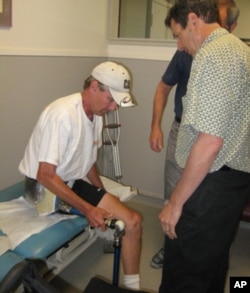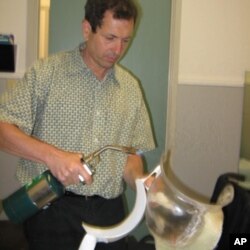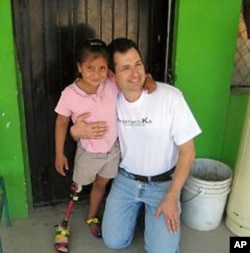Jon Batzdorff has made it his life’s work to help amputees, not only in the United States, but around the world.
His business is prosthetics and orthotics - the evaluation, fabrication and custom-fitting of artificial limbs and orthotic braces. Both an art and a science, limb replacement has come a long way since metal and wood were used to make artificial limbs.
Hands on
All Batzdorff ever wanted to do with his life was make a living working with his hands and helping people. He started building things with his parents in his childhood home in Delaware.
“We built our own furniture there. We hooked up all the light fixtures. We did plumbing work," says Batzdorff. "So I always grew up working with my hands and building things and that was really the foundation for being able to make artificial limbs.”
Batzdorff began making artificial limbs in the late 1970s, prompted by a desire to help soldiers who had returned from Vietnam as amputees. Today, he is clinical director at the Sierra Orthopedic Laboratory in Santa Rosa, California.
His main objective is for all of his patients to achieve maximum comfort, function and appearance with their new limbs. To accomplish that, he uses the latest technology, including microprocessor-controlled knees along with ankle and plastic sockets shaped to fit perfectly onto the remaining limb.
New hope
That kind of innovation is what brought John Buckley to Batzdorff, who created a snugly fitting hip socket for Buckley.
Buckley endured what Batzdorff calls the worst kind of amputation. His entire left leg and hip were removed 17 years ago to stop a fast-moving, flesh-eating disease. Because no prosthetic socket fit properly or comfortably, he chose to use a wheelchair. Now, he’s decided to try again, with a device from Batzdorff’s lab.
With the support of a walker, Buckley stands and takes one step.
"I’m on top of the world. This is very big for me," he says with a delighted laugh. "Just to be able to stand there and walk like that when in six or seven years that’s the first time I’ve stood up there in a walker and walked with nobody holding on to me.”
Going global
For decades, Batzdorff has volunteered his services in poor communities around the world. He formalized his work five years ago when he started ProsthetiKa.
The mission of the non-profit organization is to train local technicians to make and fit artificial limbs, to respond to natural disasters and to offer online consultations and instructional videos for amputees, artificial limb makers and trainers worldwide.
Batzdorff says he wanted a slogan for ProsthetiKa that would inspire confidence but also help a patient be realistic. So the motto is: "Repairing the world one step at a time."
“I tell them that if you can stand the first day and take a step, then that will be a tremendous accomplishment and that’s a goal that we can strive for," he says. "The next day, you can take two steps, the next day four, the next eight, and pretty soon you’re walking.”
The microprocessor-controlled limbs that Batzdorff builds in his workshop are made from durable, lightweight materials such as carbon composites and titanium. But in the developing world, that advanced technology is unaffordable and difficult to maintain.
So ProsthetiKa’s goal is to create sustainable, long-term projects that will eventually be run by local organizations. Batzdorff evaluates what materials are available in the area to make artificial limbs and contacts the local technicians who deliver prosthetic care.
“Even if they’re very minimally trained, we try to identify those people, meet with them and say, 'Can we help you to bring up your skills and work together side-by-side and fit the local people with prosthesis?' So, that’s what we do."
Haiti project
ProsthetiKa’s latest project is in Haiti, where the 2010 earthquake created thousands of new amputees.
Batzdorff designed, built and brought two portable labs to the devastated country, where artificial limbs are now being made. Although a local source for materials has not yet been located, Batzdorff looks at ProsthetiKa’s overall progress with great satisfaction.
“I get to participate in somebody else meeting their goals and their dreams," he says. "Their dream is to be able to walk again and I get to help facilitate that and play a part in it.”
Batzdorff will soon begin his third training session in Port au Prince. Once Haiti’s prosthetic services are up and running under local control, he plans to return to Bolivia, Mexico, Russia, Turkey, Lithuania, Armenia, Cuba and the other countries where ProsthetiKa has been laying the groundwork for local prosthetic care.











